Freesias, with their delicate blooms and captivating fragrance, hold a special place in garden landscapes worldwide. These charming flowers not only add a touch of elegance but also contribute to the overall ambiance of any garden setting. Our blog is a perfect place to find all the information you need. In this comprehensive guide, we will delve into the art of planting and caring for freesias, ensuring that you unlock their full potential in your garden.
What are Freesias?
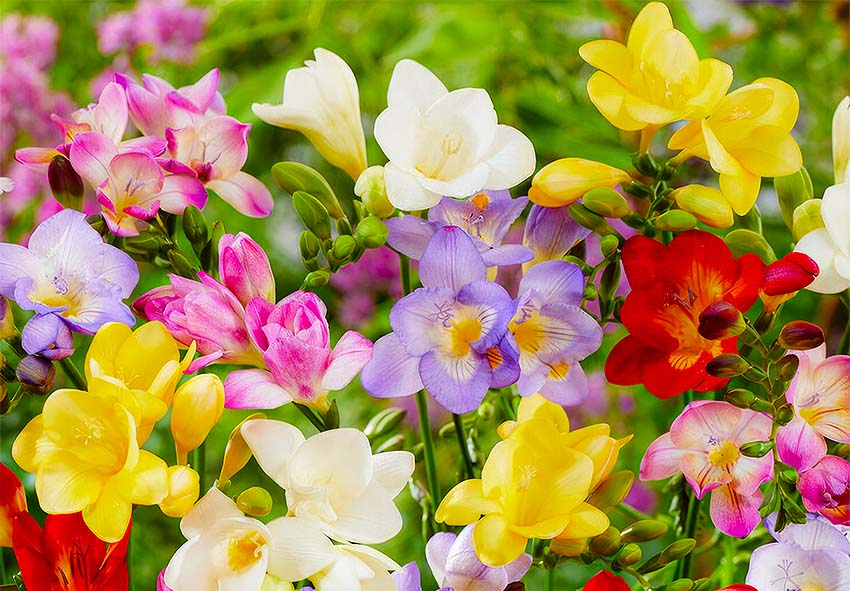
Freesias, belonging to the Iridaceae family, are beloved for their slender, funnel-shaped flowers and sweet, citrus-like scent. Originating from South Africa, these tender perennials have become popular garden additions globally for their beauty and versatility.
Description of Freesias
Freesias typically feature tall, slender stems adorned with multiple blooms in hues ranging from white and yellow to pink, red, purple, and blue. Their trumpet-shaped flowers emit a fragrance that is both delicate and intoxicating, making them a favorite among gardeners and florists alike.
Varieties Available
Over the years, breeders have developed numerous freesia cultivars, each with its unique color variations, flower sizes, and growth habits. Common varieties include single-flowered, double-flowered, and scented freesias, providing options to suit every taste and preference. Whether adorning flower beds, borders, or containers, freesias offer endless possibilities for garden design and creativity.
| Botanical Name | Usage | Colour | Flowering Period | Particularities |
| Freesia refracta | Garden beds, borders, containers | Various shades | Late winter to early spring | Highly fragrant, especially in the evenings. |
| Freesia alba | Garden beds, borders | White | Late winter to early spring | Known for its pure white blooms and fresh fragrance. |
| Freesia laxa | Containers, rock gardens | Yellow, cream | Late spring to early summer | Compact growth habit, suitable for pots and baskets. |
| Freesia corymbosa | Garden beds, borders | Pink, purple | Mid-spring to late spring | Tall spikes of fragrant flowers, perfect for cutting. |
| Freesia hybrids | Garden beds, borders, containers | Various shades | Late winter to early spring | Extensive range of colors and sizes, versatile. |
Growing Conditions for Freesias
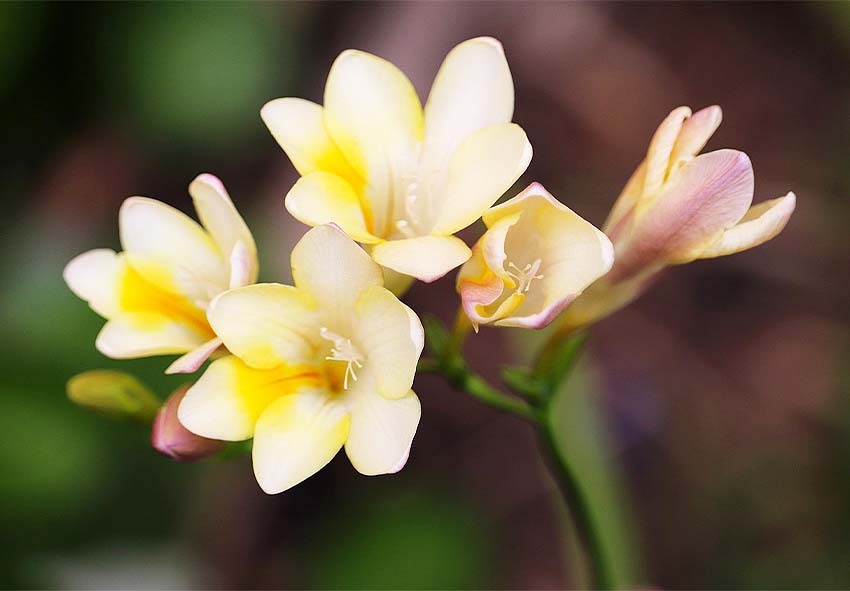
Freesias are exquisite flowering plants that require specific growing conditions to thrive and produce abundant blooms. Understanding their climate preferences, soil requirements, and sunlight needs is essential for successful cultivation.
Climate Requirements
Freesias prefer mild climates with moderate temperatures, making them well-suited for cultivation in temperate regions. Ideal temperature ranges for freesias typically fall between 50°F to 75°F (10°C to 24°C) during the growing season. They thrive in areas with mild winters and warm, dry summers, making them popular choices for gardens in Mediterranean and coastal regions.
Soil Preferences
Freesias thrive in well-drained, fertile soil that is rich in organic matter. The optimal soil type for freesias is sandy loam or loamy soil with a slightly acidic to neutral pH range between 6.0 to 7.0. Good soil drainage is crucial to prevent waterlogging, as freesia bulbs are susceptible to rot in overly wet conditions. Adding organic compost or well-rotted manure to the soil before planting can improve soil structure and fertility, providing an ideal growing medium for freesias.
Sunlight and Shade Needs
Freesias require full sunlight to partial shade to thrive and produce abundant blooms. They perform best when planted in locations that receive at least 6 to 8 hours of direct sunlight per day. However, freesias can tolerate partial shade, especially in regions with hot summers, as long as they still receive sufficient sunlight to fuel growth and flowering. Adequate sunlight exposure promotes robust plant growth and vibrant flower development, ensuring a spectacular display of color in the garden.
Planting Freesias: Preparation and Techniques
When it comes to planting freesias, timing is crucial to ensure optimal growth and blooming. Understanding the ideal planting window and considering seasonal factors can significantly impact the success of your freesia garden.
When to Plant Freesias
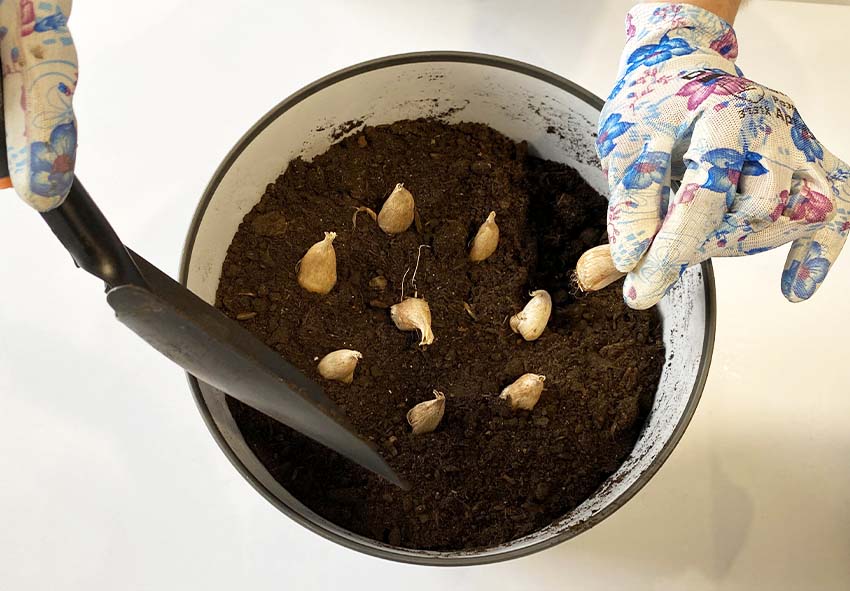
Freesias are typically planted in the fall, around 6 to 8 weeks before the first expected frost date in your area. Planting freesia bulbs in the fall allows them to establish roots before winter sets in, providing a head start for vigorous growth and blooming in the spring. In regions with mild winters, freesias can also be planted in late winter to early spring for summer flowering. However, fall planting is generally preferred to capitalize on the natural dormancy period that freesia bulbs require for optimal flowering.
Seasonal Considerations
When deciding when to plant freesias, consider the seasonal conditions in your region. In areas with cold winters, planting freesia bulbs in the fall ensures they have sufficient time to establish roots and undergo the necessary chilling period for flowering. Freesias require a period of dormancy during the winter months to initiate flower bud development.
By planting in the fall, you synchronize their growth cycle with the natural rhythm of the seasons, setting the stage for a spectacular floral display in the spring. Additionally, planting freesias in the fall allows you to take advantage of cooler temperatures and ample rainfall, providing optimal conditions for bulb establishment and early growth.
Bulb Preparation
Before planting freesia bulbs, it’s essential to prepare them properly to encourage healthy growth and flowering. Follow these steps for bulb preparation:
- Inspect Bulbs: Start by examining the freesia bulbs for any signs of damage, disease, or rot. Discard any bulbs that appear soft, mushy, or discolored, as they may not sprout or could introduce pathogens to the soil.
- Soak Bulbs: To promote hydration and kickstart the sprouting process, soak the freesia bulbs in lukewarm water for several hours or overnight. This helps rehydrate the bulbs and encourages quicker root development once planted in the soil.
- Remove Dead Material: Trim off any dead or withered roots or foliage from the freesia bulbs using clean, sharp scissors or pruning shears. Removing dead material helps prevent the spread of disease and ensures the bulb’s energy is directed towards healthy growth.
Planting Technique
Once the freesia bulbs are prepared, it’s time to plant them in the garden. Follow these guidelines for optimal planting technique:
- Depth: Plant freesia bulbs at a depth of approximately 2 to 4 inches (5 to 10 centimeters) in well-drained soil. Dig individual planting holes or prepare a trench for mass planting, ensuring adequate spacing between bulbs to allow for growth and airflow.
- Spacing: Space freesia bulbs approximately 4 to 6 inches (10 to 15 centimeters) apart to prevent overcrowding and competition for nutrients. If planting in containers or pots, space bulbs slightly closer together but ensure they have enough room to expand as they grow.
- Orientation: Plant freesia bulbs with the pointed end facing upwards and the flat or rounded end downwards. This ensures that the growing tip is positioned correctly to emerge from the soil surface and initiate growth.
- Watering: After planting, water the soil thoroughly to settle the bulbs and provide essential moisture for root development. Continue to water regularly, keeping the soil evenly moist but not waterlogged, especially during the establishment period and throughout the growing season.
Caring for Freesias: Watering and Moisture Management
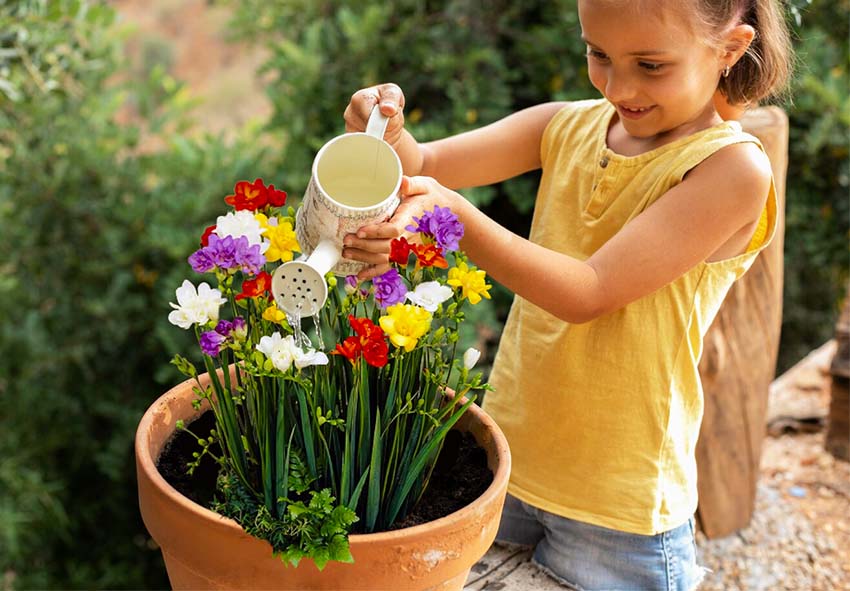
Proper watering and moisture management are crucial aspects of caring for freesias to ensure healthy growth and prolific flowering. Follow these guidelines to effectively water and manage moisture for your freesias:
Watering Frequency
Freesias have moderate water needs and prefer consistently moist soil during their active growth periods. Follow these guidelines for watering freesias:
- Establishment Period: After planting freesia bulbs, water the soil thoroughly to settle them in. Continue to water regularly, keeping the soil evenly moist but not waterlogged, until plants establish strong root systems.
- Growing Season: During the growing season, water freesias deeply and regularly, providing enough moisture to keep the soil consistently moist but not soggy. Aim to water freesias once or twice a week, adjusting frequency based on weather conditions and soil moisture levels.
- Dry Spells: During hot, dry weather or prolonged periods without rain, increase watering frequency to prevent soil from drying out completely. Freesias may require more frequent watering during these times to maintain adequate moisture levels and prevent stress.
Moisture Requirements
While freesias appreciate moist soil, it’s essential to avoid overwatering and waterlogged conditions, which can lead to root rot and other issues. Follow these tips to manage moisture effectively:
- Well-Drained Soil: Plant freesias in well-drained soil amended with organic matter to improve soil structure and drainage. Avoid heavy clay soils that retain water and increase the risk of waterlogged conditions.
- Mulching: Apply a layer of organic mulch, such as shredded bark or compost, around freesia plants to help retain soil moisture, suppress weeds, and regulate soil temperature. Mulching also helps prevent rapid evaporation of moisture from the soil surface.
- Monitoring Soil Moisture: Regularly check soil moisture levels by inserting your finger into the soil near freesia plants. Water when the top inch (2.5 centimeters) of soil feels dry to the touch, but avoid watering if the soil is still moist to prevent overwatering.
- Proper Drainage: Ensure that planting beds and containers have adequate drainage to prevent water from pooling around freesia roots. Avoid planting freesias in low-lying areas or heavy clay soils prone to waterlogging.
Fertilizing Freesias
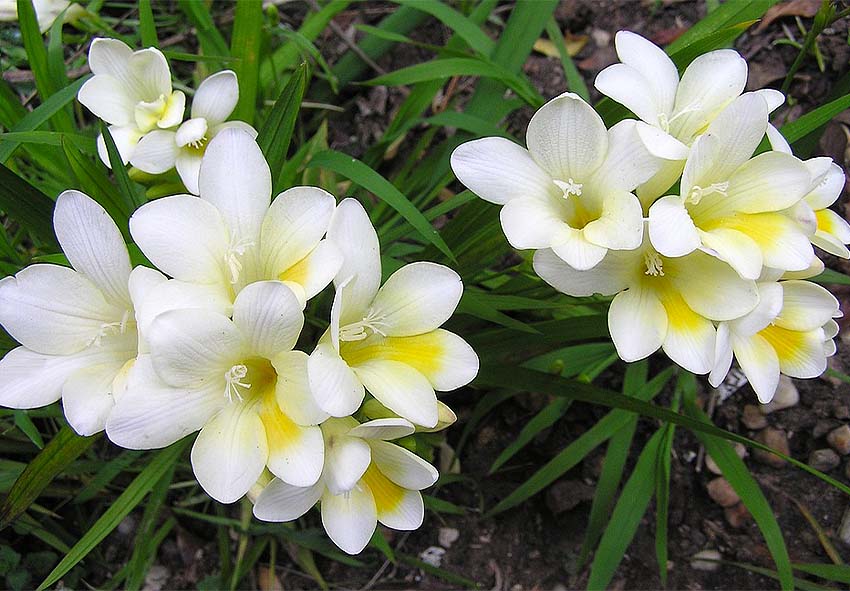
Fertilizing freesias is essential for promoting healthy growth, robust blooming, and vibrant foliage. When choosing fertilizers for your freesias, opt for balanced formulations providing equal proportions of nitrogen (N), phosphorus (P), and potassium (K). Alternatively, slow-release granular fertilizers formulated for flowering bulbs or perennials can provide nutrients gradually over time.
In terms of application schedule, begin fertilizing freesias in early spring as new growth emerges. Apply a balanced fertilizer evenly around the base of the plants, following manufacturer instructions. Provide a second application in mid to late spring, approximately 6 to 8 weeks after the initial feeding, to support ongoing growth and blooming.
Once freesias finish flowering and begin to enter dormancy in late spring or early summer, discontinue fertilization. Feeding freesias beyond this point may stimulate excessive foliage growth at the expense of flower production. In regions with mild winters, consider a light fall application to replenish soil nutrients and support bulb development during dormancy, using a low-nitrogen fertilizer to avoid excessive foliage growth.
Managing Pests and Diseases
Effectively managing pests and diseases is crucial for maintaining the health and vitality of freesias. By identifying common pests and implementing preventive measures, as well as employing strategies for disease control and prevention, you can safeguard your freesias and ensure a thriving garden.
Common Pests
Freesias may be susceptible to various pests that can affect their growth and flowering. Common pests include aphids, thrips, and spider mites. To identify and prevent pest infestations:
- Identification: Regularly inspect freesia plants for signs of pest activity, such as distorted leaves, stippling, or the presence of insects on foliage or flowers.
- Prevention Tips: Encourage natural predators such as ladybugs and lacewings, which feed on aphids and other pests. Maintain good garden hygiene by removing weeds and debris that may harbor pests. Consider using insecticidal soaps or neem oil as organic pest control methods, following label instructions carefully to minimize harm to beneficial insects.
Disease Prevention
Freesias are susceptible to certain diseases, including fungal infections such as botrytis and fusarium wilt. There are some strategies for disease control to prevent diseases and maintain plant health.
Practice proper sanitation by removing and disposing of diseased plant material promptly. Ensure adequate air circulation around freesia plants by spacing them properly and avoiding overcrowding. Water freesias at the base of the plants to minimize moisture on foliage, as excess moisture can promote fungal diseases. Apply fungicides preventively, especially during periods of high humidity or wet weather, to protect against fungal infections. Consider using organic fungicides containing copper or sulfur as alternatives to synthetic chemicals.
By staying vigilant and implementing proactive pest and disease management strategies, you can protect your freesias from potential threats and enjoy healthy, beautiful blooms throughout the growing season.
Harvesting and Maintenance

Ensuring the longevity of your freesia blooms and the health of your plants requires careful attention to harvesting techniques and regular maintenance. Here are some essential tips to consider:
- Cutting Freesia Blooms for Arrangements
When harvesting freesia blooms for arrangements, time your cuts for the early morning or late afternoon when the flowers are fully hydrated. Use sharp scissors or pruners to cut the stems at an angle, leaving at least 6 to 8 inches attached to the flower. Conditioning the stems in lukewarm water for several hours before arranging helps prolong their freshness.
- Proper Harvesting Techniques
Regularly deadhead spent freesia blooms by cutting the stems back to the base of the plant to encourage continuous flowering. Every few years, consider dividing overcrowded freesia clumps to rejuvenate the plants and prevent competition for resources. Additionally, amending the soil annually with compost or organic matter helps replenish nutrients and maintain soil fertility.
Conclusion
In conclusion, successful cultivation and care of freesias require attention to key factors such as planting, watering, fertilizing, pest and disease management, harvesting, and maintenance. By following the guidelines outlined in this guide, you can ensure the health and vitality of your freesias and enjoy a bountiful display of colorful blooms throughout the growing season. You can also find more guides, like guide to Orchids, on our blog.
As you apply the knowledge gained from this guide to your own gardening endeavors, take pride in cultivating beautiful freesias that bring joy and color to your garden landscape. With proper care and attention, your freesias will reward you with an abundance of fragrant blooms, enhancing the beauty of your outdoor space for years to come. Happy gardening!
Frequently Asked Questions (FAQs) about Freesias
1. How should I plant freesia bulbs for optimal growth and blooming?
Plant freesia bulbs in well-drained soil, spacing them 2-3 inches apart and planting them at a depth of 2-3 times the bulb’s height. Ensure they receive full sunlight or partial shade for optimal growth and blooming.
2. How can I order Holland freesia from your online store?
Ordering Holland freesia from our online store Dutch-bulbs.com is simple and convenient. Visit our website and browse our selection of freesia varieties, including those sourced from Holland for their exceptional quality and beauty. Once your order is confirmed, our team will carefully pack and ship your Holland freesia bulbs directly to your doorstep, ensuring they arrive fresh and ready for planting.
3. How often should I water freesias, and what is the best watering technique to avoid overwatering?
Freesias require regular watering, providing them with moisture when the top inch of soil feels dry. Water deeply but infrequently to prevent waterlogged conditions, especially during dormancy periods.
4. When is the best time to prune freesias, and what pruning methods should I use to promote healthy growth and flowering?
Prune freesias after flowering has finished by removing spent flower stems and dead foliage. Trim back any overcrowded or damaged foliage to improve airflow and reduce the risk of disease.
5. Are there any common pests or diseases that affect freesias, and how can I prevent and manage them effectively?
Freesias are relatively pest and disease-resistant, but they may occasionally encounter problems such as aphids or fungal diseases like botrytis. Monitor plants regularly for signs of pests or diseases and treat promptly with appropriate methods such as insecticidal soap or fungicides as needed. Proper cultural practices, including adequate spacing and good air circulation, can also help prevent pest and disease issues.
Published: 28.03.2024
